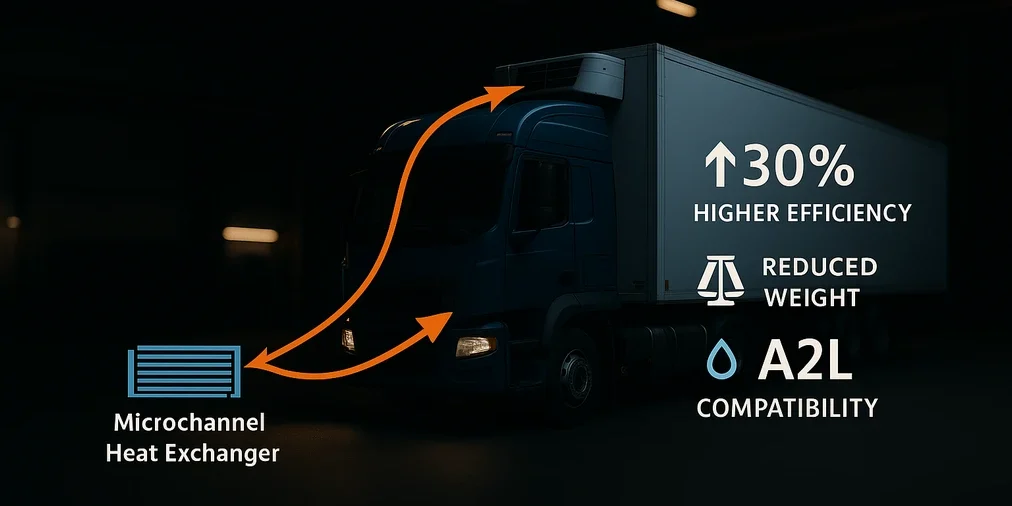Fundamentals of a Vehicle Cooling System
A robust vehicle cooling system safeguards engine performance, passenger comfort, and cargo integrity. Whether you refer to it as a vehicle cooling system, its core components—radiator, coils, heat exchangers, coolant pump—must operate in harmony. Climetal’s microchannel technology delivers superior heat transfer in a compact footprint, reducing weight and energy use. Our designs integrate seamlessly with gas cooler setups for CO₂ refrigeration and dry cooler systems for water-free operation.Why Microchannel Heat Exchangers Matter
Climetal is Europe’s #1 manufacturer of custom microchannel solutionsTraditional coils are bulky and less efficient. Our microchannel heat exchangers enhance any vehicle cooling system by offering:
- Up to 30% higher thermal efficiency
- Reduced coolant volume and pressure drop
- Advanced e‑coating protection for corrosion resistance
- Support modern A2L refrigerants, enabling OEMs to meet EU F-Gas regulations
Supporting Cold Chain Logistics & Cold Storage Solutions
In the world of cold chain logistics, maintaining precise temperatures is non‑negotiable. Climetal’s heat exchangers enable refrigerated trailers and vans to perform flawlessly, complementing turnkey cold storage solutions. By integrating our modules into your vehicle cooling system, you ensure perishable goods—from pharmaceuticals to fresh produce—remain within strict temperature tolerances.Custom Design for Every Vehicle Cooling System
No two fleets are identical. Our engineering team tailors each vehicle cooling system package—ports, mounting brackets, and interface controls—to your chassis specifications. Whether retrofitting buses, specialty trucks or outfitting mobile clinics, Climetal’s solutions guarantee plug‑and‑play integration, rapid installation and minimized downtime.Efficiency, Sustainability & Lifecycle Savings
Lightweight microchannels and minimal refrigerant charge translate into significant fuel savings and lower emissions. Combined with durable e‑coating, your vehicle cooling system enjoys extended service intervals, fewer replacements, and reduced total cost of ownership over its lifecycle.Frequently Asked Questions about Vehicle Cooling Systems
What is the vehicle cooling system?
The vehicle cooling system combines radiators, microchannel heat exchangers, coolant pumps, and fans to keep engine and cabin temperatures optimal—protecting performance, safety, and comfort across all vehicle types.
What is a refrigerated trailer unit?
It’s a self-contained refrigeration unit that keeps cargo at the required temperature during transport. The system uses a compressor, condenser coil (often a microchannel heat exchanger), evaporator coil, and fans to remove heat from the trailer’s interior. The refrigerant circulates through these components, absorbing heat inside the cargo space and releasing it outside. In many modern units, gas coolers or dry coolers improve efficiency, and designs can be optimized for A2L refrigerants to meet environmental regulations. This ensures perishable goods—such as food, pharmaceuticals, or chemicals—stay within strict temperature limits from origin to delivery.
Why choose microchannel heat exchangers?
Climetal’s microchannel heat exchangers provide up to 30% higher thermal efficiency, reduced refrigerant volume, lower pressure drop, and advanced e‑coating for outstanding corrosion resistance and long service life.
How do microchannel exchangers benefit cold chain logistics?
Integrated in refrigerated trailers and vans, microchannel units maintain precise temperatures, ensuring pharmaceutical and food safety throughout cold chain logistics and storage.
Can Climetal customize a vehicle cooling system solution?
Yes, our engineers customize every detail—ports, mounting, and refrigerant compatibility—ensuring seamless integration into your vehicle fleet or specialized application.
What sustainability advantages do Climetal solutions offer?
Our lightweight, efficient microchannel heat exchangers minimize fuel consumption and emissions, while durable e‑coating and recyclability lower environmental impact and lifecycle costs.







